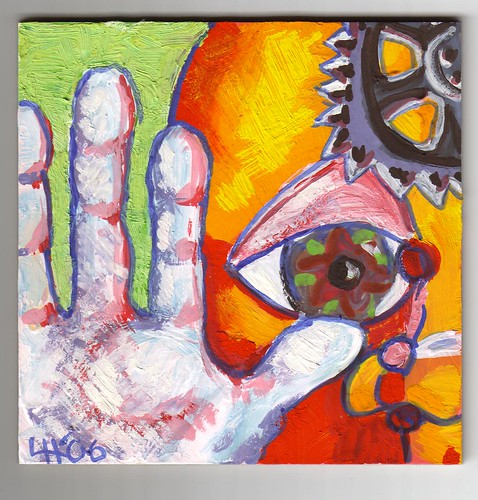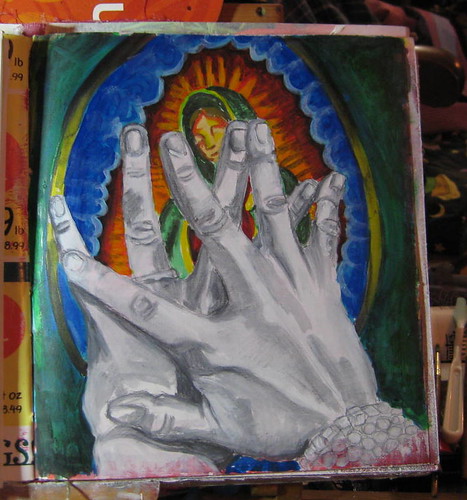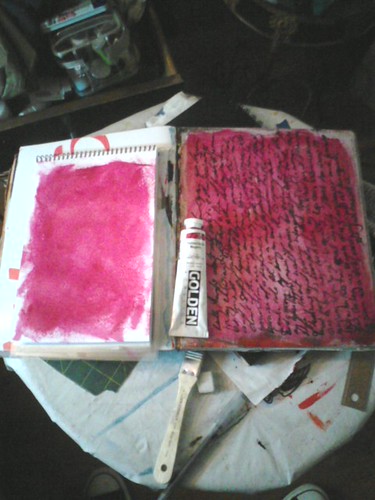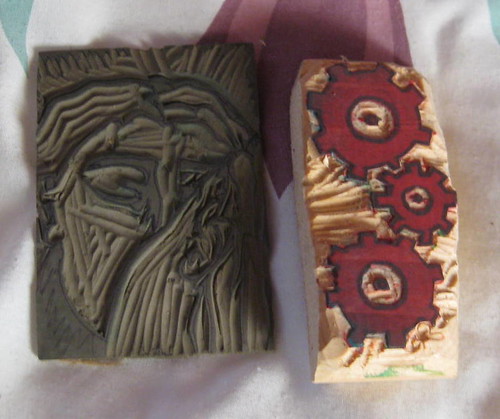 |
| copyright Leslie Herger |
Art journaling is a mix of everything I’ve done artistically in my life. I’ve always kept a written journal and a sketchbook. I moved to Massachusetts and was hit by a car when I was commuting home from work on my bike. While I wasn’t hurt it’s sort of the genesis point for when I started to glue “shit” into my journal and started to write in my sketchbook. I had mixed some notes in my sketchbook but never to the extent I do now.
How would you define art journaling to someone who is brand new to it?
I like to show people the Dan Eldon website, Sketchbob’s site and a couple of books like Journal Junkies or Gwen Dhien. Art journaling is a combination of visual and written, it’s journal and sketchbook combined. It activates the right side of the brain for out of the box thinking.
Why did you decide to start artjournaling.ning.com?
I have been a member of Julie Pritchard’s lostluggage network, Williowing’s and another person’s. I love all those sites but I wanted to create something that was solely focused on art journaling. I wanted to create a group that was free to join and had the feeling that Willowing’s group but with less focus on drawing faces, pretty girls and the like. I work grungy and I knew that there had to be more people like myself who are interested in exploring the darker side of art journaling and with it our own dark side. I wanted a place where all people felt welcome. I avoid pink in my site purposefully.
Essentially I wanted to create a site like lostluggage, but open to anyone and with the sort of camadre that willowing had on her site.
What's been the best part about the art journal group?
The open discussion, if you delve into the forums for more than a glancing look there is a ton of information. If you search for a term you’ll find a lot of discussion on it.
What's the worst part?
Administration and having to tell people no. I decided early on that the focus of the forum had to be narrow- art journaling ONLY. That means if you journal on ATC and load it up you better explain that in the description of your images. There are plenty of places to discuss ATC/ACEO and scrapping. We’re the only open forum for art journaling.
 |
| copyright Leslie Herger |
A fountain pen with waterproof/resistant ink like noodlers- a good ink in a good pen feels really good. Even good ink in a cheap fountain pen. You can get a Platinum Preppy FP for $3 on Jetpens.com and noodler’s for $13 and it’s worth every penny. Even though it’s a cheap pen the preppy performs well and you’ll find yourself wanting to draw and write with it. It’s the power of a good ink. I have a few pricier pens but I reach for the cheap pens first.
Watercolors- pans, tubes, crayons or pencils, I like color. I use a cotman pan travel set of watercolors and some water brushes to apply large washes and small areas of color. If I want a toned page I’ll reach for something else. Most of my travel journals are watercolor and ink.
A good journal with 140lb watercolor paper, I like strathmore and fabriano. When I’m feeling snobbish I go for Fabriano then cheap strathmore. All my travel journals are made with strathmore 400 series cold pressed. It’s 140lb, very inexpensive and easy to work with when binding. I’ve made an assortment of other books with Fabriano, but I’m cheap and balk at prices. Jerry’s artarama and Cheap Joe’s have good prices.
Pencils- I use an assortment of pencils in my journals ranging from H up to 6B.
gesso- Don’t leave home with out it. Seriously, I even put gesso, both clear and white in my travel kits.
Acrylic Paint- As a painter I use liquitex brand paints and I use the same heavy body paints in my art journals with a variety of mediums. I can glaze my pages, tone the pages, put a painting in the journal or whatever on them. Versatile and fun, acrylic keeps my pages from being boring.
What artists inspire you & why?
Hannah Hoch and other Dadaists- Hoch was one of the first peopel to cut photos and images from magazines and turn them into amazing images. After the weimar era she didn’t do much artistically but when she was making art, wow, was she AMAZING! the rest of the Dadaists can be blamed for modern art.
Picasso- While he was a misogynist his variety of work and ambition are amazing to me. His prints are delightful. There is a movie of picasso working on frosted mylar. It shows his drawing process andit’s backed with silence or jazz. Great movie.
Matisse- I’m a HUGE fan of matisse, who did amazing things with cut pieces of paper. He and Hoch approched collage in 2 very different manners.
Van Gogh- He’s proof that hard work pays off. take a look at he online gallery of his work. The early drawings were rough and he had issues with perspective and the body. After delibirate work his work emerges as some of the best drawings I’ve ever seen. The fact that he drew them with a reed pen is even more amazing. Everytime I look at his work I want to pick up a bottle of sepia ink and a reed pen and draw.
Hockney- Constantly changes and tries new things. A modern picasso for sure. I love his work on multiple canvases and his photo collages.
All the artists on Art Journaling Ning. every day as I approve photos I’m amazed at the talent and diversity of experience reflected in the journals posted.
What is the most rewarding part of finishing a journal?
Starting a new one.
 |
| copyright Leslie Herger |
How long do you take to finish a journal?
It varies a lot. I tend to work in 4 or 5 at a time. If I’m working in one I can make it through in 3 months or less. Currently I’m developing a class, so I’m writing a lot in a separate journal and my art journal is mostly for large washes of color and gluing stuff in.
How do you know when you are finished with a journal page? Is it a gut feeling or something else? Artist Teesha Moore says that you should push past the feeling of thinking a page is finished at least twice. Do you agree or disagree?
Disagree. When its done its done I don’t work on it any more. I work on a thought or a feeling on a page and once it’s worked out I move on. Sometimes a page isn’t “done” but I move on anyway. I have pages I’ll never finish in some of my art journals, and I think it’s part of the process.I don’t look at my art journals as finished pieces of art, more of process. I don’t strive to create finished art in my journal at all. I use it as a place to work out thoughts, feeling and ideas about other art. It’s part sketchbook and part written journal. I happen to combine the two. When I start to feel like I’m creating finished pieces of art, I shift gears and force myself to work with just pen, ink and watercolor, or just gluing stuff to a page.
How does art journaling reflect your personality?
Most of all it reflects my thought process. I tend to think about stuff in depth only when I’m ready, ignore it until I can deal. In my art journal I’m much more direct. It also reflects my daily life. I’m a big fan of gluing in the detritus of daily life. I’ll collect wrappers, business cards, receipts and other junk and tape or glue it to the pages of my art journal. Sometimes I’ll layer acrylic paint over it, sometimes just leave it.
 |
| copyright Leslie Herger |
What's your art background?
I started making art in elementary school. My family is very crafty. My mom does cross stitch, knitting, crochet, stamping and now quilts almost exclusively. Growing up where I did you had to have a hobby or go crazy in the long cold winter nights. I think my parents were happy that a pencil and a sketchbook kept me busy for hours.
In HS I proceeded to take all the art classes I could and much to my school and parent’s disappointment started to apply to art schools. I went to the University of Maine, Orono campus on a presidential scholarship that paid for 1/3 of my tuition. The rest came from private endowments. I was very lucky to go to school for nearly free and even more lucky to have found a contact in finacial aid that took an interest in my staying in school and helped me to apply for scholarships throughout my years at UMaine. It enabled me to explore a lot of art methods and materials. My degree is in art with a concentration in education. I also have an unfinished minor in Psychology.
How does your day job tie in with your art making, if at all?
It doesn’t. I’m in HR for a fortune 500 company. I took the job because it was 40 hours a week and when the work day ended so did my job. I did this so I could focus on art outside of work.
What resources would you recommend for art journalers just starting out?
I think ArtJournaling.ning.com is a fantastic resource. I also think that looking at YouTube videos by art journalers like Millande, Willowing, EvelineTimeless and others is really helpful. Also there is a network of UStreamers where you can watch hour to 2 hour long shows on art journaling almost every night of the week. It’s amazing, inspirational and a treasure trove of information. I’d also suggest ofr the less techie people Journal Junkies, Any Gwen Diehn book and a few others.
 |
| copyright Leslie Herger |
Do you have a favorite journal / paper that you use for your work?
My go to for inexpensive paper is Strathmore 400 series watercolor and drawing papers. My lust after paper is Fabriano Artistico. I bind my own journals from larger sheets of paper rather than relying on prebound sketchbooks.
What do you do with your journals when you finish them? How many would you estimate that you have finished?
I’ve probably got 30 finished journals, another 15 or so partially finished with no intent to finish them ever and 3 or 4 in process. I’ve got the most recent dozen stored on a shelf over my desk for quick reference. The rest are stored in a shelf in my studio. I’ve lost 2 or 3 over the years. And I’ve got another 2 in storage at my parent’s place.
Do you work in your art journal daily? Do you have any other daily creative practices?
I go through phases, right now I’m in a non-art journal phase and in a written word phase. I’m working on class development and spending a lot of time researching my ideas and writing up what I want my class to entail. I’m big on planning and once I have things planned I can wing it on camera. As long as I have an outline of what SHOULD happen it does. My classes have been referred to as very Zen.
So probably until I’m done with my class development I’ll remain writing and then I’ll start to art in my journals again. I’ve got 3 art journalis in progress right now all waiting for me to work in them.
What do you do if you are fresh out of ideas?
I head to my book shelf or flickr and look. Sometimes I’ll just read something not related to art at all, sometimes I’ll crack open a book binding book, it all varies depending on my mood. Sometimes just stepping away from the issue solves it. I’m a fan of taking a break and walking to the Atomic for a cappuccino.
Do you have any favorite teachers / instructors?
Tamara Laporte of Willowing.org is amazing
Julie Pritchard and Chris Cozen of lostluggage.com put on some high quality classes geared toward fine art but put forth a lot of info that related to mixed media.
Klair Scattergood of Rhomany’s Realm
_______________
See all of my Artist Interviews here.

Very nice interview! Thanks for sharing, and for picking Leslie, as she's a great teacher and an inspiration.
ReplyDeleteGreat interview, Less!
ReplyDeleteExcellent interview! Keep these up! I'm now a follower ; )
ReplyDeleteLotus
lootsvele@yahoo.com
Nice interview. I think Leslie is a breath of fresh air and very real. I, too, get tired of all the "pretty" stuff, I find it gets boring after a while. I like Leslie's style and have even purchased some of her handmade journals, they really are great. I especially love the covers. thanks for the interview, very inspiring!
ReplyDelete